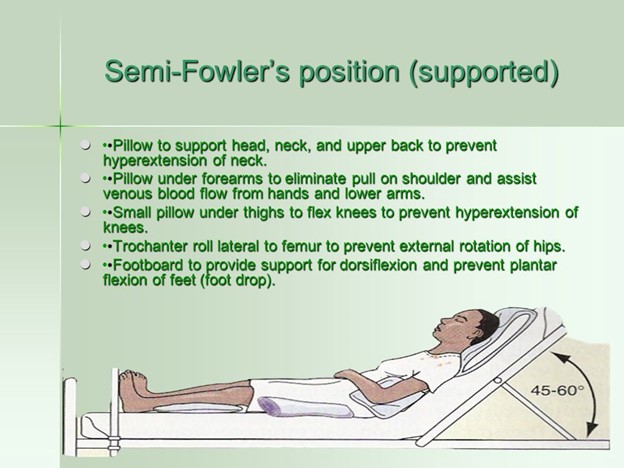A nurse in an emergency department is caring for a client who has appendicitis. Which of the following actions should the nurse take?
Maintain the client in a semi-Fowler's position.
Administer an enema 1 hr prior to surgery.
Apply a warm pack to the client's lower abdomen.
Place the client on a clear liquid diet.
The Correct Answer is A
Choice A rationale:

The nurse should maintain the client in a semi-Fowler's position to promote comfort and reduce the risk of complications related to appendicitis. This position helps to decrease pressure on the abdomen and may alleviate pain by reducing tension on the abdominal muscles.
Choice B rationale:
Administering an enema 1 hour prior to surgery is not indicated for a client with appendicitis. Enemas are generally not recommended for clients with suspected or confirmed appendicitis as they can potentially worsen inflammation and cause perforation of the inflamed appendix.
Choice C rationale:
Applying a warm pack to the client's lower abdomen is contraindicated in appendicitis. Heat can exacerbate inflammation and should be avoided in such cases.
Choice D rationale:
Placing the client on a clear liquid diet is not appropriate for appendicitis. Clients with appendicitis are typically NPO (nothing by mouth) to avoid stimulating the gastrointestinal tract and reduce the risk of rupture if surgery is needed.
Nursing Test Bank
Naxlex Comprehensive Predictor Exams
Related Questions
Correct Answer is A
Explanation
"I changed the floor plan of our home to accommodate my father's wheelchair.”.
Choice A rationale:
This statement indicates acceptance of the role change as a caregiver for the aging parents. Making changes to the home to accommodate the father's wheelchair demonstrates the client's willingness to adapt and provide a suitable environment for caregiving.
Choice B rationale:
Feeling stressed out and overwhelmed does not necessarily indicate acceptance of the role change. It may reflect the challenges and emotional burden that come with caregiving but does not necessarily signify acceptance.
Choice C rationale:
Expressing frustration with caregiving does not necessarily indicate acceptance of the role change. It is normal to feel frustrated at times, especially when dealing with chronic illnesses, but acceptance involves embracing the responsibilities that come with the role.
Choice D rationale:
While the statement shows a willingness to learn and adapt to caregiving, it does not explicitly indicate acceptance of the role change. Acceptance involves acknowledging and embracing the new responsibilities and challenges fully.
Correct Answer is D
Explanation
Choice A rationale:
A warm left leg is a normal finding and does not require immediate intervention. Warmth indicates adequate circulation to the limb.
Choice B rationale:
A pedal pulse strength of 2 in the left leg indicates diminished pulse but does not require immediate intervention. The nurse should continue to monitor the pulse and report any significant changes to the healthcare provider.
Choice C rationale:
The client's report of pain in the foot of the left leg is an expected finding due to the fractured left femur. Pain is a subjective symptom, and the nurse should address the client's pain appropriately but not intervene immediately based on this finding.
Choice D rationale:
This is the correct choice. A capillary refill time of 3 seconds in the left foot suggests impaired circulation, which could be indicative of compartment syndrome or other circulation-related issues. The nurse should intervene immediately by notifying the healthcare provider to prevent further complications.
Whether you are a student looking to ace your exams or a practicing nurse seeking to enhance your expertise , our nursing education contents will empower you with the confidence and competence to make a difference in the lives of patients and become a respected leader in the healthcare field.
Visit Naxlex, invest in your future and unlock endless possibilities with our unparalleled nursing education contents today
Report Wrong Answer on the Current Question
Do you disagree with the answer? If yes, what is your expected answer? Explain.
Kindly be descriptive with the issue you are facing.
